【原】Coursera—Andrew Ng机器学习—编程作业 Programming Exercise 4—反向传播神经网络
课程笔记
Coursera—Andrew Ng机器学习—课程笔记 Lecture 9_Neural Networks learning
作业说明
Exercise 4,Week 5,实现反向传播 backpropagation神经网络算法, 对图片中手写数字 0-9 进行识别。
数据集 :ex4data1.mat。手写数字图片数据,5000个样例。每张图片20px * 20px,也就是一共400个特征。数据集X维度为5000 * 400
ex4weights.mat。神经网络每一层的权重。
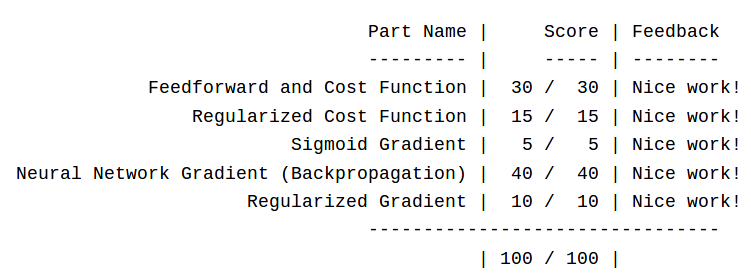
文件清单
ex4.m- Octave/MATLAB script that steps you through the exercise
ex4data1.mat- Training set of hand-written digits
ex4weights.mat- Neural network parameters for exercise 4
submit.m- Submission script that sends your solutions to our servers
displayData.m- Function to help visualize the dataset
fmincg.m- Function minimization routine (similar to fminunc)
sigmoid.m- Sigmoid function
computeNumericalGradient.m- Numerically compute gradients
checkNNGradients.m- Function to help check your gradients
debugInitializeWeights.m- Function for initializing weights
predict.m- Neural network prediction function
[*] sigmoidGradient.m- Compute the gradient of the sigmoid function
[*] randInitializeWeights.m- Randomly initialize weights
[*] nnCostFunction.m- Neural network cost function
* 为必须要完成的
结论
和上一周的作业一样。因为Octave里数组下标从1开始。所以这里将分类结果0用10替代。预测结果中的1-10代表图片数字为1,2,3,4,5,6,7,8,9,0
矩阵运算 tricky 的地方在于维度对应,哪里需要转置很关键。
1 神经网络
1.1 数据可视化
在数据集X里随机选择100个数字,绘制图像
displayData.m:
function [h, display_array] = displayData(X, example_width)
%DISPLAYDATA Display 2D data in a nice grid
% [h, display_array] = DISPLAYDATA(X, example_width) displays 2D data
% stored in X in a nice grid. It returns the figure handle h and the
% displayed array if requested. % Set example_width automatically if not passed in
if ~exist('example_width', 'var') || isempty(example_width)
example_width = round(sqrt(size(X, 2)));
end % Gray Image
colormap(gray); % Compute rows, cols
[m n] = size(X);
example_height = (n / example_width); % Compute number of items to display
display_rows = floor(sqrt(m));
display_cols = ceil(m / display_rows); % Between images padding
pad = 1; % Setup blank display
display_array = - ones(pad + display_rows * (example_height + pad), ...
pad + display_cols * (example_width + pad)); % Copy each example into a patch on the display array
curr_ex = 1;
for j = 1:display_rows
for i = 1:display_cols
if curr_ex > m,
break;
end
% Copy the patch % Get the max value of the patch
max_val = max(abs(X(curr_ex, :)));
display_array(pad + (j - 1) * (example_height + pad) + (1:example_height), ...
pad + (i - 1) * (example_width + pad) + (1:example_width)) = ...
reshape(X(curr_ex, :), example_height, example_width) / max_val;
curr_ex = curr_ex + 1;
end
if curr_ex > m,
break;
end
end % Display Image
h = imagesc(display_array, [-1 1]); % Do not show axis
axis image off drawnow; end
ex4.m里的调用
load('ex4data1.mat');
m = size(X, );
% Randomly select data points to display
sel = randperm(size(X, ));
sel = sel(:);
displayData(X(sel, :));
运行效果如下:

1.2 模型表示
ex4.m 里载入已经调好的权重矩阵weight。
% Load saved matrices from file
load('ex4weights.mat');
% The matrices Theta1 and Theta2 will now be in your workspace
% Theta1 has size 25 x 401
% Theta2 has size 10 x
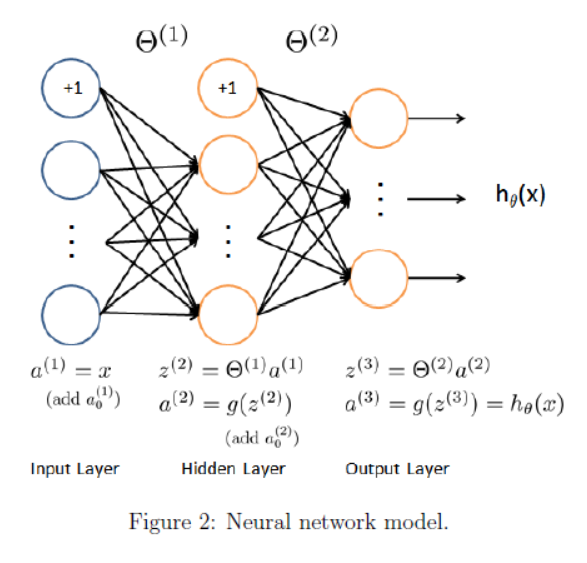
这里g(z) 使用 sigmoid 函数。
神经网络中,从上到下的每个原点是 feature 特征 x0, x1, x2...,不是实例。计算过程其实就是 feature 一层一层映射的过程。一层转换之后,feature可能变多、也可能变少。下一层 i+1层 feature 的个数是通过权重矩阵里当前 θ(i) 的 row 行数来控制。
两层权重 θ 已经在 ex4weights.mat 里给出。从a1映射到a2权重矩阵 θ1为 25 * 401,从a2映射到a3权重矩阵 θ2为10 * 26。因为最后有10个分类。(这意味着运算的时候要注意转置)
1.3 前馈神经网络和代价函数
首先完成不包含正则项的代价函数,公式如下:

注意,和之前不同的是: 由于y是范围0-9的数字,计算之前需要转换为下面这种向量的形式:
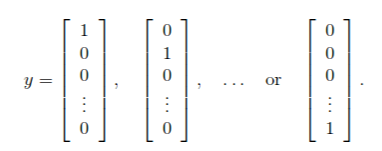
代码为:
% convert y(-) to vector
c = :num_labels;
yt = zeros(m,num_labels);
for i = :m
yt(i,:) = (c==y(i));
end
nnCostFunction.m 计算代价函数的代码如下:
% compute h(x)
a1 = [ones(m, ) X]; %5000x401
a2 = sigmoid(a1 * Theta1'); %5000x401乘以401x25得到5000x25。即把401个feature映射到25 a2 = [ones(m, ) a2]; %5000x26
hx = sigmoid(a2 * Theta2'); %5000x26乘以26x10得到5000x10。即把26个feature映射到10 % first term
part1 = -yt.*log(hx);
% second term
part2 = (-yt).*log(-hx);
% compute J
J = / m * sum(sum(part1 - part2));
需要注意的是,上一次作业里逻辑回归的代价函数计算使用的是矩阵相乘的方式
part1 = -yt' * log(hx); part2 = (1-yt') * log(1-hx);
而这里神经网络的公式中有两层求和,需要使用 “矩阵点乘,sum,再sum” 的方式计算。 如果使用矩阵相乘省略一层sum,结果会出错。
1.4 正则化的代价函数
给神经网络中的代价函数加上正则项,公式如下:

nnCostFunction.m 代码如下:
% convert y(-) to vector
c = :num_labels;
yt = zeros(m,num_labels);
for i = :m
yt(i,:) = (c==y(i));
end % compute h(x)
a1 = [ones(m, ) X]; %5000x401
a2 = sigmoid(a1 * Theta1'); %5000x401乘以401x25得到5000x25。即把401个feature映射到25 a2 = [ones(m, ) a2]; %5000x26
hx = sigmoid(a2 * Theta2'); %5000x26乘以26x10得到5000x10。即把26个feature映射到10 % first term
part1 = -yt.*log(hx);
% second term
part2 = (-yt).*log(-hx); % regularization term
regTerm = lambda / / m * (sum(sum(Theta1(:,:end).^)) + sum(sum(Theta2(:,:end).^))); % J with regularization
J = / m * sum(sum(part1 - part2)) + regTerm;
ex4.m 里的调用如下:
% 不使用正则化
lambda = 0;
J = nnCostFunction(nn_params, input_layer_size, hidden_layer_size, ...
num_labels, X, y, lambda); % 使用正则化
lambda = 1;
J = nnCostFunction(nn_params, input_layer_size, hidden_layer_size, ...
num_labels, X, y, lambda);
2 反向传播
2.1 sigmoid gradient
计算sigmoid函数的梯度,公式如下:

sigmoidGradient.m
function g = sigmoidGradient(z)
%SIGMOIDGRADIENT returns the gradient of the sigmoid function
%evaluated at z
% g = SIGMOIDGRADIENT(z) computes the gradient of the sigmoid function
% evaluated at z. This should work regardless if z is a matrix or a
% vector. In particular, if z is a vector or matrix, you should return
% the gradient for each element.
g = sigmoid(z).*(-sigmoid(z)); //要求对向量和矩阵同样适用,所以使用点乘而不是直接相乘 end
ex4.m中的调用
%% ================ Part : Sigmoid Gradient ================ g = sigmoidGradient([ -0.5 0.5 ]);
fprintf('Sigmoid gradient evaluated at [1 -0.5 0 0.5 1]:\n ');
fprintf('%f ', g);
2.2 随机初始化
在训练神经网络时,随机初始化参数来进行对称破坏非常重要。随机初始化的一个有效策略是在
的范围内统一随机选择 θ(l)的值,你应该使用 εinit = 0.12。 这里对值的选择有一个说明:

randInitializeWeights.m
function W = randInitializeWeights(L_in, L_out)
%RANDINITIALIZEWEIGHTS Randomly initialize the weights of a layer with L_in
%incoming connections and L_out outgoing connections
% W = RANDINITIALIZEWEIGHTS(L_in, L_out) randomly initializes the weights
% of a layer with L_in incoming connections and L_out outgoing
% connections.
%
% Note that W should be set to a matrix of size(L_out, + L_in) as
% the column row of W handles the "bias" terms epsilon_init = 0.12;
W = rand(L_out, + L_in) * * epsilon_init - epsilon_init; end
ex4.m 里的调用为:
%% ================ Part : Initializing Pameters ================ initial_Theta1 = randInitializeWeights(input_layer_size, hidden_layer_size);
initial_Theta2 = randInitializeWeights(hidden_layer_size, num_labels); % Unroll parameters
initial_nn_params = [initial_Theta1(:) ; initial_Theta2(:)];
2.3 反向传播
反向传播算法,由右到左计算误差项 δj(l):
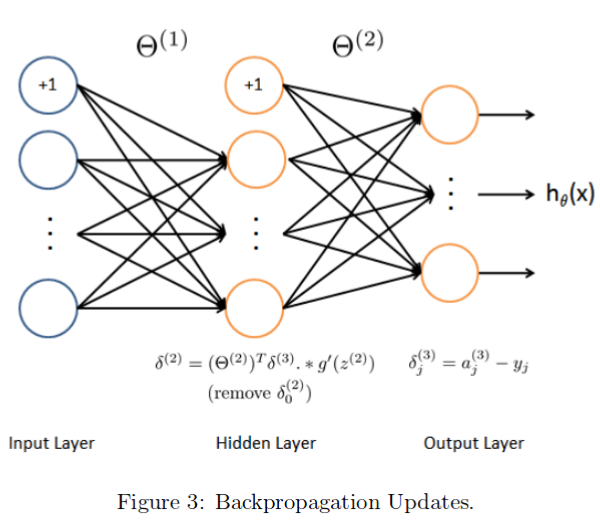
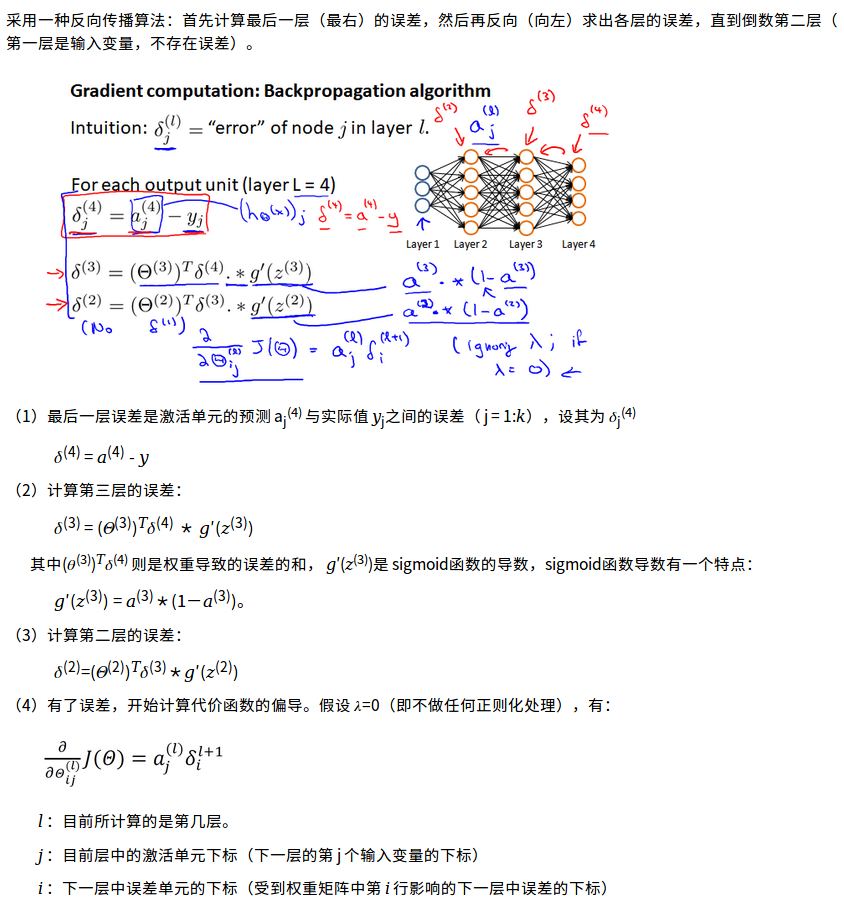
详细请看我的课程笔记:Coursera—Andrew Ng机器学习—课程笔记 Lecture 9_Neural Networks learning
(1)根据上面的公式计算 “误差项 error term”。 代码如下:
%----------------------------PART ----------------------------------
% Accumulate the error term
delta_3 = hx - yt; % x
delta_2 = delta_3 * Theta2 .* sigmoidGradient([ones(m, ) z2]); % x = x * x .* x 26 % 去掉 δ2(0) 这一项
delta_2 = delta_2(:,:end); % x 25
(2)计算梯度,公式和代码如下:

% Accumulate the gradient
D2 = delta_3' * a2; % 10 x 26 = 10 x 5000 * 5000 x 26
D1 = delta_2' * a1; % 25 x 401 = 25 x 5000 * 5000 x 401
(4)获得代价函数 J(θ)针对Theta1 和 Theta2 的偏导数 ,公式和代码如下:

% Obtain the (unregularized) gradient for the neural network cost function
Theta2_grad = /m * D2;
Theta1_grad = /m * D1;
2.4 梯度校验
梯度校验的原理:
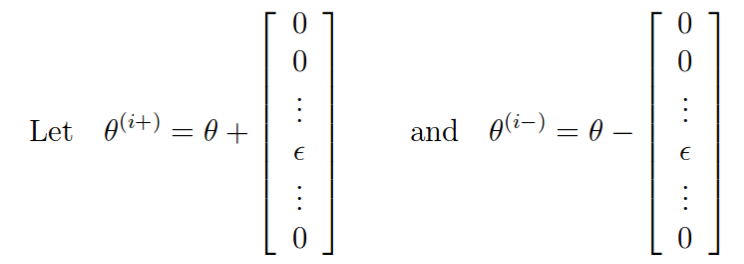
如果梯度计算正确,则下面两个值的差应该比较小

在 computeNumericalGradient.m 中,已经实现了梯度校验的过程,它会生成一个小型神经网络和数据集 来进行校验。如果梯度计算正确,会得到一个小于 e-9 的差值。
在真正开始模型学习时,需要关闭梯度校验。
2.5 正则化神经网络
上面计算出的偏导数没有加入正则项, 加入正则项的公式如下 ( j = 0 不参与正则化,即将θ的第一列置为0)
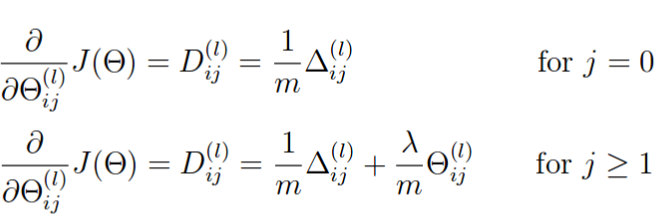
%----------------------------PART ----------------------------------
%---Regularize gradients
temp1 = Theta1;
temp2 = Theta2;
temp1(:,) = ; % set first column to
temp2(:,) = ; % set first column to
Theta1_grad = Theta1_grad + lambda/m * temp1;
Theta2_grad = Theta2_grad + lambda/m * temp2;
ex4.m 中的调用:
%% =============== Part : Implement Regularization =============== % Check gradients by running checkNNGradients
lambda = ;
checkNNGradients(lambda); % Also output the costFunction debugging values
debug_J = nnCostFunction(nn_params, input_layer_size, ...
hidden_layer_size, num_labels, X, y, lambda);
2.6 使用 fmincg 函数训练参数
ex4.m 中的调用如下:
%% =================== Part : Training NN ===================
options = optimset('MaxIter', );
% You should also try different values of lambda
lambda = ;
% Create "short hand" for the cost function to be minimized
costFunction = @(p) nnCostFunction(p, ...
input_layer_size, ...
hidden_layer_size, ...
num_labels, X, y, lambda);
% Now, costFunction is a function that takes in only one argument (the
% neural network parameters)
[nn_params, cost] = fmincg(costFunction, initial_nn_params, options);% Obtain Theta1 and Theta2 back from nn_params
Theta1 = reshape(nn_params(:hidden_layer_size * (input_layer_size + )), ...
hidden_layer_size, (input_layer_size + ));
Theta2 = reshape(nn_params(( + (hidden_layer_size * (input_layer_size + ))):end), ...
num_labels, (hidden_layer_size + ));
3 可视化hidden layer
如果我们将 Theta1 中的一行拿出来,去掉了第一个 bias term,得到一个 400 维的向量。可视化hidden单元的一种方法,就是将这个 400 维向量重新整形为 20×20 图像,并显示它。
ex4.m 中的调用如下:
%% ================= Part : Visualize Weights ================= displayData(Theta1(:, :end)); % 去掉第一列
图像如下,Theta1 的每一行对应一个小格子:
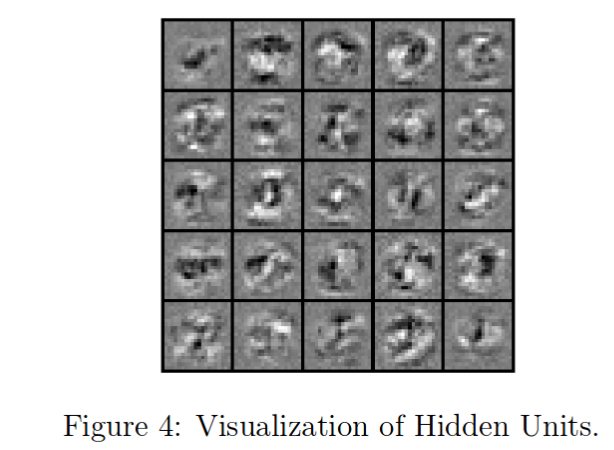
4 预测
预测准确率为 94.34%。 我们引入正则化的作用是避免过拟合,如果将2.6中的 λ 设置为 0 或一个小数值,或者通过调整MaxIter,甚至可能得到一个准确率为100%的模型。但这种模型对于预测新来的数据,表现可能很差。
ex4.m 中的调用如下
%% ================= Part : Implement Predict ================= pred = predict(Theta1, Theta2, X);
5 运行结果
运行ex4.m 得到的结果如下:
Loading and Visualizing Data ... Program paused. Press enter to continue. Loading Saved Neural Network Parameters ... Feedforward Using Neural Network ...
Cost at parameters (loaded from ex4weights): 0.287629
(this value should be about 0.287629) Program paused. Press enter to continue. Checking Cost Function (w/ Regularization) ...
Cost at parameters (loaded from ex4weights): 0.383770
(this value should be about 0.383770)
Program paused. Press enter to continue. Evaluating sigmoid gradient...
Sigmoid gradient evaluated at [ -0.5 0.5 ]:
0.196612 0.235004 0.250000 0.235004 0.196612 Program paused. Press enter to continue. Initializing Neural Network Parameters ... Checking Backpropagation...
-0.0093 -0.0093
0.0089 0.0089
-0.0084 -0.0084
0.0076 0.0076
-0.0067 -0.0067
-0.0000 -0.0000
0.0000 0.0000
-0.0000 -0.0000
0.0000 0.0000
-0.0000 -0.0000
-0.0002 -0.0002
0.0002 0.0002
-0.0003 -0.0003
0.0003 0.0003
-0.0004 -0.0004
-0.0001 -0.0001
0.0001 0.0001
-0.0001 -0.0001
0.0002 0.0002
-0.0002 -0.0002
0.3145 0.3145
0.1111 0.1111
0.0974 0.0974
0.1641 0.1641
0.0576 0.0576
0.0505 0.0505
0.1646 0.1646
0.0578 0.0578
0.0508 0.0508
0.1583 0.1583
0.0559 0.0559
0.0492 0.0492
0.1511 0.1511
0.0537 0.0537
0.0471 0.0471
0.1496 0.1496
0.0532 0.0532
0.0466 0.0466 The above two columns you get should be very similar.
(Left-Your Numerical Gradient, Right-Analytical Gradient) If your backpropagation implementation is correct, then
the relative difference will be small (less than 1e-). Relative Difference: 2.2366e-11 Program paused. Press enter to continue. Checking Backpropagation (w/ Regularization) ...
-0.0093 -0.0093
0.0089 0.0089
-0.0084 -0.0084
0.0076 0.0076
-0.0067 -0.0067
-0.0168 -0.0168
0.0394 0.0394
0.0593 0.0593
0.0248 0.0248
-0.0327 -0.0327
-0.0602 -0.0602
-0.0320 -0.0320
0.0249 0.0249
0.0598 0.0598
0.0386 0.0386
-0.0174 -0.0174
-0.0576 -0.0576
-0.0452 -0.0452
0.0091 0.0091
0.0546 0.0546
0.3145 0.3145
0.1111 0.1111
0.0974 0.0974
0.1187 0.1187
0.0000 0.0000
0.0337 0.0337
0.2040 0.2040
0.1171 0.1171
0.0755 0.0755
0.1257 0.1257
-0.0041 -0.0041
0.0170 0.0170
0.1763 0.1763
0.1131 0.1131
0.0862 0.0862
0.1323 0.1323
-0.0045 -0.0045
0.0015 0.0015 The above two columns you get should be very similar.
(Left-Your Numerical Gradient, Right-Analytical Gradient) If your backpropagation implementation is correct, then
the relative difference will be small (less than 1e-). Relative Difference: 2.17629e-11 Cost at (fixed) debugging parameters (w/ lambda = ): 0.576051
(this value should be about 0.576051) Program paused. Press enter to continue. Training Neural Network...
Iteration | Cost: 3.298708e+00
Iteration | Cost: 3.254768e+00
Iteration | Cost: 3.209718e+00 Iteration | Cost: 3.124366e+00
Iteration | Cost: 2.858652e+00
Iteration | Cost: 2.454280e+00
Iteration | Cost: 2.259612e+00
Iteration | Cost: 2.184967e+00 Iteration | Cost: 1.895567e+00
Iteration | Cost: 1.794052e+00
Iteration | Cost: 1.658111e+00
Iteration | Cost: 1.551086e+00
Iteration | Cost: 1.440756e+00
Iteration | Cost: 1.319321e+00
Iteration | Cost: 1.218193e+00
Iteration | Cost: 1.174144e+00 >>
Iteration | Cost: 1.121406e+00
Iteration | Cost: 1.001795e+00
Iteration | Cost: 9.730070e-01
Iteration | Cost: 9.396211e-01
Iteration | Cost: 8.982489e-01
Iteration | Cost: 8.785754e-01
Iteration | Cost: 8.558708e-01 Iteration | Cost: 8.358078e-01
Iteration | Cost: 8.074475e-01
Iteration | Cost: 7.975287e-01
Iteration | Cost: 7.883648e-01
Iteration | Cost: 7.543000e-01
Iteration | Cost: 7.318456e-01 Iteration | Cost: 7.151468e-01
Iteration | Cost: 6.919630e-01
Iteration | Cost: 6.823971e-01
Iteration | Cost: 6.766813e-01
Iteration | Cost: 6.639429e-01
Iteration | Cost: 6.579100e-01 Iteration | Cost: 6.491120e-01
Iteration | Cost: 6.405250e-01
Iteration | Cost: 6.318625e-01
Iteration | Cost: 6.180036e-01
Iteration | Cost: 6.081649e-01
Iteration | Cost: 5.973954e-01
Iteration | Cost: 5.684440e-01 Iteration | Cost: 5.465935e-01
Iteration | Cost: 5.399081e-01
Iteration | Cost: 5.320386e-01
Iteration | Cost: 5.289632e-01
Iteration | Cost: 5.252995e-01
Iteration | Cost: 5.236517e-01
Iteration | Cost: 5.233562e-01 Iteration | Cost: 5.197894e-01
Program paused. Press enter to continue. Visualizing Neural Network... Program paused. Press enter to continue. Training Set Accuracy: 94.340000
https://github.com/madoubao/coursera_machine_learning/tree/master/homework/machine-learning-ex4/ex4
【原】Coursera—Andrew Ng机器学习—编程作业 Programming Exercise 4—反向传播神经网络的更多相关文章
- 【原】Coursera—Andrew Ng机器学习—编程作业 Programming Exercise 1 线性回归
作业说明 Exercise 1,Week 2,使用Octave实现线性回归模型.数据集 ex1data1.txt ,ex1data2.txt 单变量线性回归必须实现,实现代价函数计算Computin ...
- 【原】Coursera—Andrew Ng机器学习—编程作业 Programming Exercise 2——逻辑回归
作业说明 Exercise 2,Week 3,使用Octave实现逻辑回归模型.数据集 ex2data1.txt ,ex2data2.txt 实现 Sigmoid .代价函数计算Computing ...
- 【原】Coursera—Andrew Ng机器学习—编程作业 Programming Exercise 3—多分类逻辑回归和神经网络
作业说明 Exercise 3,Week 4,使用Octave实现图片中手写数字 0-9 的识别,采用两种方式(1)多分类逻辑回归(2)多分类神经网络.对比结果. (1)多分类逻辑回归:实现 lrCo ...
- Andrew Ng机器学习编程作业: Linear Regression
编程作业有两个文件 1.machine-learning-live-scripts(此为脚本文件方便作业) 2.machine-learning-ex1(此为作业文件) 将这两个文件解压拖入matla ...
- Andrew NG 机器学习编程作业4 Octave
问题描述:利用BP神经网络对识别阿拉伯数字(0-9) 训练数据集(training set)如下:一共有5000个训练实例(training instance),每个训练实例是一个400维特征的列向量 ...
- Andrew Ng机器学习编程作业:Neural Network Learning
作业文件: machine-learning-ex4 1. 神经网络 在之前的练习中,我们已经实现了神经网络的前反馈传播算法,并且使用这个算法通过作业给的参数值预测了手写体数字.这个练习中,我们将实现 ...
- Andrew Ng机器学习编程作业:Logistic Regression
编程作业文件: machine-learning-ex2 1. Logistic Regression (逻辑回归) 有之前学生的数据,建立逻辑回归模型预测,根据两次考试结果预测一个学生是否有资格被大 ...
- Andrew Ng机器学习编程作业:Regularized Linear Regression and Bias/Variance
作业文件: machine-learning-ex5 1. 正则化线性回归 在本次练习的前半部分,我们将会正则化的线性回归模型来利用水库中水位的变化预测流出大坝的水量,后半部分我们对调试的学习算法进行 ...
- Andrew NG 机器学习编程作业5 Octave
问题描述:根据水库中蓄水标线(water level) 使用正则化的线性回归模型预 水流量(water flowing out of dam),然后 debug 学习算法 以及 讨论偏差和方差对 该线 ...
随机推荐
- 【模板】NTT
NTT模板 #include<bits/stdc++.h> using namespace std; #define LL long long const int MAXL=22; con ...
- spring boot 使用spring.resources.static-locations 分离系统模版&&资源文件
方便我们将资源配置以及模版&&静态文件分离出来,而不是打包在一起,比如以下的一个demo 参考配置: server.port=8006 spring.application.name= ...
- 【转】无需root Android 4.4现已支持显示电量百分比
原文网址:http://android.tgbus.com/shouji/news/201311/481145.shtml 现如今,大多数安卓设备.第三方ROM都可以在状态栏以百分比的形式精确显示剩余 ...
- 研究ecmall一些流程、结构笔记 (转)
index.phpECMall::startup() //ecmall.php object //所有类的基础类 ecmall.phpBaseApp //控制器基础类 app.base.phpECBa ...
- python-生成测试报告-然后自动发送邮件
前两篇单独介绍了生成测试报告和自动发送邮件,那么现在把两者整合到一起:生成测试报告后然后自动发送邮件,这里只是简单的整合实现功能,其实还可以优化的,先用吧,后面再慢慢优化 先看下目录,其实目录还是一样 ...
- GNU Radio安装教程: Ubuntu14.04 + uhd3.10.0 + gnuradio3.7.10.1
1. 更新和安装依赖项 在编译安装uhd和gnuradio之前,确保已安装所需依赖项.Ubuntu系统运行: sudo apt-get update 安装UHD和GNURadio所需依赖项: On U ...
- springmvc之获取参数
1.导包,四大核心包,一个切面包(AOP),logging,web,springmvc 2.配置文件,核心代码如下: web.xml <servlet> <servlet-name& ...
- 使用GDI+保存带Alpha通道的图像
带Alpha通道的图像(ARBG)在通过GDIPlus::Bitmap::FromHBITMAP等转为GDI+位图,再存储时,透明区域会变成纯黑(也有可能是纯白?). 网上找了两段保持透明的实现代 ...
- FC Switch sfpshow
sfpshow - fault-finding on Brocade Fibre Channel Switches So you've hit a situation where a Fibre Ch ...
- IT诗词
年少太轻狂,误入IT行.白发森森立,两眼直茫茫.语言数十种,无一称擅长.三十而立时,无房单身郎. 年少不经事,埋头编程忙. 指键铿锵落,不及细思量. bug千百个,comment无一行. 休言敏捷易, ...
